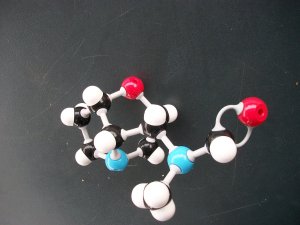For at least a week, this molecular model was on our liquor cabinet:
 I remembered assembling and photographing it afterwards, in fact from two different angles, as shown here. But what was it? The memory completely escaped me. Surely if it had captivated me enough I would have mentioned something to my wife. “Something about a plant,” is all she could recall. I proceeded to take the model back out on the deck where the picture was taken, hoping the location would help revive the memory. But it was to no avail.
I remembered assembling and photographing it afterwards, in fact from two different angles, as shown here. But what was it? The memory completely escaped me. Surely if it had captivated me enough I would have mentioned something to my wife. “Something about a plant,” is all she could recall. I proceeded to take the model back out on the deck where the picture was taken, hoping the location would help revive the memory. But it was to no avail.
I let it go because my wife saw in me the early signs of obsession. I’ve been known to hound a lost object or memory consistently for hours, sometimes weeks, rarely failing to find it but at the expense of more important things that need attention around the house, around life.
A few days later, at the sight of the model, I decided to punch in its molecular formula, C9H14N2O2, into ChemSpider. As expected the formula led to too many isomers— totally different molecules that share the same ratios of elements. An advanced search, however, allowed me to draw the exact structure, an intriguing heterocyclic arrangement of 7 atoms but fused to two smaller rings, which share either the nitrogen or oxygen atom with the larger ring.
When the search button was hit, “N-formylloline” came up. It still did not ring a bell, so I turned to Google.
It led me to a paper mentioning that a fungus, Neotyphodium uncinatum, accumulates N-formylloline. The real molecule, whose model I had built but forgotten why, is toxic to Hemipteran insects—the family of true bugs including cicadas, aphids, hoppers. I then remembered thinking, “what a neat natural pesticide”. But how I had stumbled upon the compound was still a mystery.
It was the next fact that did it. The fungus is an endophyte of the Italian ryegrass, meaning that it’s symbiotically attached to the plant without harming it. And that jogged my memory! Something I had been reading in Italian referred to the “parobola della zizzania“, what we refer to in English as the “parable of the weeds” in the New Testament.
The servants asked him, ‘Do you want us to go and pull them up?’
‘No,’ he answered, ‘because while you are pulling the weeds, you may uproot the wheat with them.
But I knew “weeds” was not a perfect translation because the zizzania isn’t just any weed; it specifically refers to Italian ryegrass, Lolium multiflorum. Unfamiliar with the plant, I had looked it up and that’s when I had come across the uncharacteristic structure of N-formylloline and built the model!



